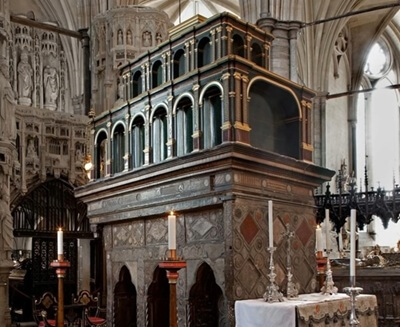Edith, the first recorded owner of the Manor of Amersham
By Alison Bailey

The first named person to appear in Amersham Museum’s Timeline is Queen Edith, the wife of Edward the Confessor. When her brother King Harold was defeated at the battle of Hastings in 1066, she was the richest woman in England. She owned extensive lands in the south of England including the manor of Amersham. On her death, William the Conqueror gave her land to the Norman Geoffrey de Mandeville, the first sheriff of London.
Although scarcely remembered today, Edith was a remarkable woman whose story should be better known. She played a substantial role in the development of medieval England and commissioned the Vita Ædwardi Regis, the Life of King Edward. One of the most important primary sources of the period, the book ensured that her family’s side of the story was told and that she was portrayed as virtuous, noble and pious.
Edith of Wessex
Edith was half Danish and half English. Born around 1025, she is the daughter of Godwin, one of the most ambitious and powerful earls in England. A minor noble of the South Saxons, Godwin rose to prominence as a fearsome warrior at the court of King Cnut and was made Earl of Wessex. After suppressing a rebellion in Denmark, he married Gytha, the sister-in-law of King Cnut, and produced at least nine children.
To help fulfil his political ambitions, Godwin wanted to prepare Edith for an important life, so she was sent to be educated at the Wilton Abbey near Salisbury with other noble women. She spoke several languages including French, Latin, Danish and Irish and was accomplished at arithmetic and astronomy. She was also musical and learnt embroidery and weaving.
Queen Edith
Edith became Queen of England when she married Edward, the half English, half Norman son of Ethelred the Unready and Emma of Normandy in 1045. Edward was around 20 years older than her and had spent many years in exile in Normandy. Following the death of his half-brother Harthacnut, Edward, a French speaker, returned to claim the English throne in 1042. This restored the House of Wessex after 26 years of Danish rule.
Godwin had supported Edward’s claim to the throne and in return demanded that Edward marry his daughter. Edith was the main pawn in Godwin’s game to rule England, as he wanted his future grandson to be King. Edward held Godwin responsible for the murder of his brother and didn’t trust him, but he had little choice.
Edith was crowned Queen and received land and properties as part of her marriage settlement. She began to improve Edward’s image by dressing him in regal clothes and jewels. But the great tragedy of the marriage was that it did not produce children and historians have argued about the possible reasons for this. Unusually for the time, Edward did not father any illegitimate children either and may have been infertile. As it was the first duty of the queen to provide heirs to the throne, this did not help relations between Edward and her family as he considered replacing her with a new wife. The increasing influence of Norman lords at the court placed her in a precarious position. When Edward appointed Robert of Jumièges, an enemy of the Godwins as Archbishop of Canterbury in 1051, Godwin and the King fell out in spectacular fashion. The earl and his sons fled the country whilst Edith was banished to a nunnery and her lands confiscated.
Godwin returned to England in 1052 with a substantial military force. Edward was prepared to fight, but he knew that this would be extremely unpopular with the people and backed down. Godwin asked for forgiveness and the return of his lands. Edward gave in and Edith returned to court with more power and control as evidenced by the number of charters she witnessed. She may have abused her power though and had a nobleman murdered at the request of her favourite brother Tostig.
Succession

When her father died unexpectedly in 1053, her brothers took control of important land in the north and south of the kingdom, leaving Edward sidelined to hunt and to do “pious works” according to the Vita. Edward became ill and died in January 1066. Edith’s older brother, Harold was elected King by the council but immediately had to fight off an invasion by the Norwegian Harald Hardrada, supported by Tostig who died at the Battle of Stamford Bridge in September. The two brothers had tragically fallen out the previous year and this ultimately led to the family’s downfall and the success of the Norman invasion.
Harold and two more brothers, Gyrth, and Leofwine were killed at the Battle of Hastings in October 1066 and William the Conqueror became King of England. William sent men to Winchester to demand tribute from Edith. Ever the diplomat, she willingly complied and allied herself to the new king. William respected the former queen and allowed her to keep all her land and income. Art historian Carola Hicks suggests that she was also the author of the Bayeux Tapestry, saying that she used it to show support for the Norman invasion, whilst not destroying the English legacy, attempting to become a unifying force of peace. Edith is one of only three women depicted in the tapestry, warming the feet of her husband on his death bed. Edith died 18 December 1075, in her mid-fifties and was buried with Edward in Westminster Abbey with all the honour due to her position.

Legacy

Queen Edith was a great patron of the arts and religion. She played a crucial part in the construction of Westminster Abbey and rebuilt her beloved Wilton Abbey in stone. Undoubtedly her greatest achievement was the Vita Ædwardi Regis which managed to secure the Godwin family legacy. Whilst describing the family’s triumphs and blaming others for their failings, she successfully presented herself as the hero of the story.

